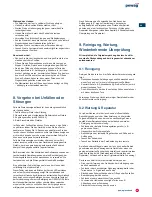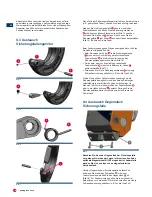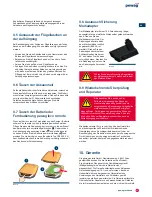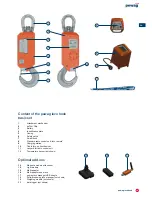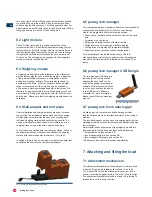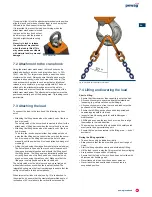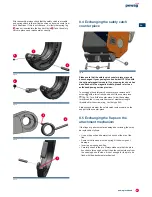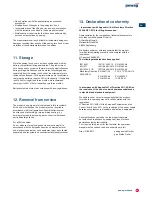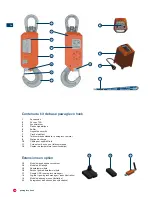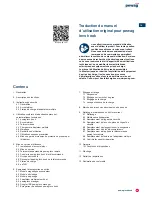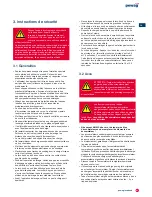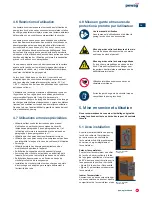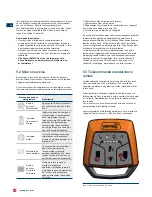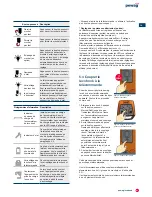
29
pewag levo hook
EN
If you would like to lock the attachment mechanism in position,
align the levo hook (when not under load) in such a way that
the load to be lifted cannot turn when lifted.
It is important to prevent the load from turning when the
attachment mechanism is locked
in place as the levo hook will not
be able to turn with the load and
the load might therefore swing
back.
Never try to lock or release
the attachment mechanism
when the load is lifted! This
may cause serious accidents
with material and/or personal
damage.
7.2 Attachment to the crane hook
Using the attachment mechanism, the levo hook may be
attached directly to a crane hook (single hook acc. to DIN
15401, size 2.5). For larger crane hooks, a transition link or
similar must be used. Always ensure that all parts have the
required load capacity (crane hook, transition link etc.) The
connection must be made in such a way that unintentional
release is not possible (e.g. using a safety catch). The hook
attached to the attachment mechanism must be able to
move freely and must not touch the screw or the side of the
attachment mechanism. The attachment mechanism must be
positioned centrally and at the bearing area. Tip-loading is not
permissible.
7.3 Attaching the load
To connect the load to the levo hook, the following options
exist:
• Attaching the lifting device when the swivel hook of the levo
hook is closed.
The safety catch of the swivel hook is pivoted to allow for the
attachment of lifting devices when the swivel hook is closed.
• Attaching the lifting device when the swivel hook of the levo
hook is open.
To do this, the levo hook must either be positioned in such
a way that the lifting device cannot slide out when the swivel
hook is closed, or the lifting device must be held in place
manually until the swivel hook is closed (attention: danger of
crushing!).
• Lifting the load using the magnetic module (optional add-on)
The swivel hook is open and the levo hook is lowered until
the magnetic module touches and attracts the lifting eye of
the lifting device. The lifting eye is automatically positioned
correctly. As soon as this has been done, the swivel hook
may be closed using the radio control. Make sure that the
lifting eye is safely positioned in the closed hook.
The safety catch must be able to move and close freely and
without obstructions even when the load is attached. The
integrated spring must be free from damage to ensure that the
safety catch is able to lock automatically.
When two master links or loops (see fig. 13) are attached to
the swivel hook, ensure that the maximally permitted angle of
inclination of 30° in relation to the vertical is not exceeded.
7.4 Lifting and lowering the load
Prior to lifting:
• Ensure that the maximum load capacity is not exceeded.
• All connections must be secured against unintentional
loosening (e.g. safety catches, screw fittings)
• All connections must be free to move and loads must be
positioned at the bearing area.
• Ensure that all lifting devices have been inspected and
deemed appropriate for the load.
• Inspect all load-bearing parts for visible damage or
modifications.
• All lifting devices and the levo hook must be free to align
themselves in the load direction.
• The swivel hook must be fully closed and the safety catch
must rest in the appropriate support.
• Ensure that no persons remain in the lifting area --> risk of
accidents!
During the lifting operation:
• The hook may only be loaded vertically.
• Always ensure that the load is within your direct range of
vision.
• Start the lifting operation slowly and avoid abrupt lifting.
• Lift the load in such a way that it is prevented from swinging.
• Avoid sudden stops and shock-loading.
• Ensure that the load or the levo hook does not collide with
objects and/or building parts.
• Never transport a load over the heads of persons.
• Never leave the load unattended or unsecured in a
suspended position.
fig. 13: maximally permitted angle of inclination
fig. 12: foldable clips
fig. 11: levo manager USB Dongle

